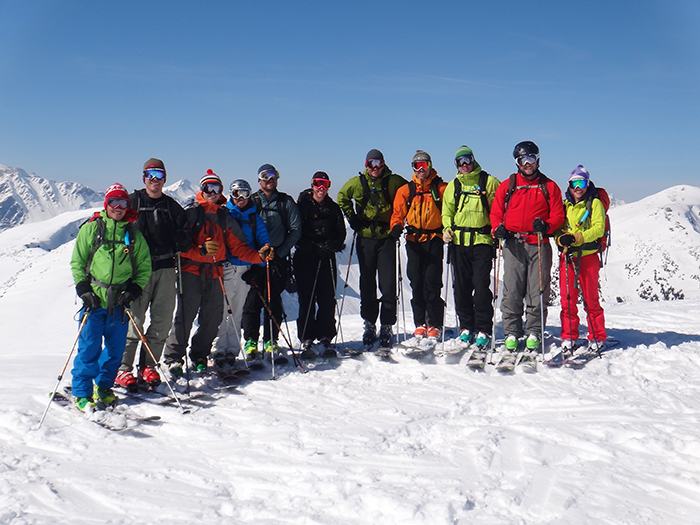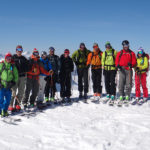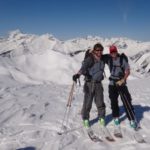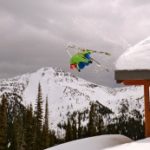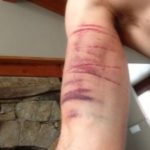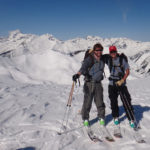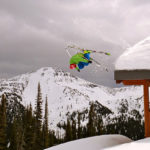Sentry Lodge, Selkirk Mountains, British ColumbiaÂ
On March 30th, eleven close friends were tossed out of a helicopter. We clutched our skis in the shadows of the rugged Selkirk Mountains as the chopper arced away. The nearest road was days away by foot, and we were left to our own devices for seven days. Both of our maps lacked Siri’s soothing voice advising us on the daily snow stability, the wind direction and speed, what monstrous peaks were safe to ski, and what terrain traps would swallow us whole. I looked around to see who I would eat first if it came to it. It was undoubtedly Steph.
Okay, I admit it wasn’t really as ominous as I just made it sound. We were city folks paying for a backcountry ski vacation. The chopper was a radio call away. Our homebase was a 4,000 square foot self-sustained mansion with a sauna, shower, indoor plumbing, piles of meat, pallets of fruit snacks, cases of alcohol, and wireless internet. We padded around in fuzzy slippers whilst doing yoga, playing Yahtzee and ping-pong, and downloading GPS coordinates into our Macbooks. Our party comprised of two paramedics, three WEMTs, three WFRs, one WFA, and four current or former ski patrollers. From RMI, we had Andrew Cull (Founder and VP), Kevin Thompson (Director, Field Services), Brent Molsberry and Dave Svobodny (instructors and medical support staff), and myself (General Counsel).
I contrast our luxurious abode and our pursuits for a reason. Regardless of how comfortable we felt when we rose in the morning or lay our heads down at night, every one of us knew that putting our skis on each morning was a risk. It’s no secret that backcountry skiing doles out injuries. Trees and rocks scrape and bruise. Crashes lead to fractures, dislocations, and sprains. Avalanches bludgeon and suffocate. When you’re skinning up a slope or standing above a chute, no technology or forecast can tell you whether the snow will hold when you make that kick turn or ski cut for the first, second, or twentieth time. No medical training or backcountry experience can overcome a 100’ wide slab slide with a 5’ crown, and no plush accommodations can match an operating room at a Level One Trauma Center.
Planning. Although eliminating risk was impossible, we were able to minimize danger through careful planning. From a medical perspective, we learned beforehand that the lodge had basic extrication equipment and first aid supplies. We supplemented this with our own large kit to be left at the lodge. Each skier was to carry a smaller personal kit throughout the day with the thought that each individual should be able to care for him/herself in the case of separation. Everyone carried a shovel, probe, and beacon.
Execution. Each morning’s outing began with a discussion on snow stability and where we were going to ski. We packed adequate food and water and checked our beacons. Experience and familiarity led to a natural dynamic in how the group skinned and skied. Stronger skinners spread themselves out amongst the group on the ascent, alternating between breaking trail and taking up the rear to ensure everyone made it up safely. At transitions, we dug hasty pits and discussed the slope to be skied, alternate routes down, run-outs, and safety zones. On descents, one of the stronger skiers would ski cut and make their way down first, followed by the rest of the group one by one. The last one down played sentry and sweeper.
As the week progressed, the group naturally divided into smaller factions based on energy level, skiing ability, and risk aversion. When a skier ventured off, we always ensured they never traveled alone, told us where they planned on going, and actually knew where that was.
Results. The trip ended with two broken ribs, a pectoral muscle tear, and two injured knees. All three patients were assessed and the injuries rested, iced, compressed, and elevated. The resting was done in the evenings and not for days or even weeks as is ideal under normal circumstances. However, that’s a pretty unreasonable request when the mountains beckoned and the vacation days dwindled. The true resting had to wait until we returned home.
For eleven backcountry skiers skiing 3,000 to 7,000 vertical feet a day for seven days straight in unknown and rugged terrain, I would consider these results a respectable outcome.
Backcountry skiing is an amazing endeavor. There is nothing like the sight of untouched peaks: mean yet inviting. There is no equal to floating through powder untainted by another’s weight. The taste of a mouthful of cresting snow cannot be explained in words. There is no jubilation like throwing a double Yahtzee at the end of the day with your closest friends, safe and sound. And there is nothing more comforting than vanquishing the thought of eating Steph from your mind because you were adequately prepared.
